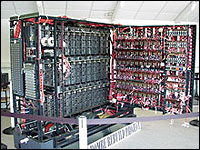![]()
The contents on this page remain on our website for informational purposes only.
Content on this page will not be reviewed or updated.
 |
|
 |
|
|
||||
|
‘Bombes’ and Bombs - Alan Turing, & Shenley Brook End
|
||||
|
||||
|
As recently reported in the Citizen, the Alan Turing papers have now been secured for the nation, to be rightfully housed at Bletchley Park. With the outbreak of war, Alan had reported for duty at Bletchley Park on September 4th 1939, and there he became instrumental in decoding the German messages, a feat greatly assisted by the development of the cryptographic ‘bombe,’ the first British designed version of which had become available by the end of May 1940.
For much of the war he was accommodated at the Crown Inn, at Shenley Brook End, and there he would sometimes be found helping out behind the bar. However, having left for Cambridge the day before, he had a lucky escape on October 28th 1940 when German bombs fell on the village, disrupting the village water main, blocking the road with debris, and damaging 11 houses. In fact with the ceilings of their cottage blown in, the elderly Mr. and Mrs. Roberts had to seek temporary accommodation at the inn, where at the time Mr. and Mrs. Bourn had been having a drink. Alarmingly a bomb had dropped not a hundred yards away, but for them the experience was nothing new, for they had already experienced bomb blasts not only in that war, but even earlier, for whilst living in Hackney, where Mr. Bourne had an upholstery business, they had been bombed during the First World War. Then on the night of September 19th 1940 their home and business were totally destroyed in the Blitz. Fortunately they had taken refuge in a shelter, and the next day set off for Bletchley with their married daughter, the school of whose children had been evacuated to the town. Providing them with assistance, a friend of the daughter met them in Bletchley, and from there they then moved to a cottage at Shenley - which was damaged by the bombs. Yet it seems this was not the only bombing of the village, for during September a high explosive bomb had fallen in a local field. Fortunately it failed to explode, and with the area quickly roped off, danger boards were erected and the livestock removed, with the police mounting guard until 6a.m. Subsequently from the Bomb Disposal Section at Reading, Second Lieutenant How-White arrived to inspect the area, and following his investigation he stated that no further action should be taken until September 8th. However, he didn’t turn up on that date, although he perhaps made an appearance in late October 1940 when, having landed 100 yards from Dovecote Farm, another high explosive bomb fell, damaging the windows. Again the area was roped off, with danger boards erected. Yet despite such dangers Alan remained at the Crown, from where he would cycle each day to Bletchley Park whatever the weather, even spurning the use of an official car. His achievements in breaking the German codes would be vital, but inevitably the strain proved immense and Mrs. Ramshaw, his landlady, became so concerned at his mumblings, alone in his upstairs room, that she contacted the medical authorities. Nevertheless, towards the end of the war Alan became involved in another secret project, and for two days a week for six months would cycle to Hanslope Park, moving to the Officers Mess in 1944. As for the Crown, this had been a pub since at least 1820. In 1853 the licence had been transferred from John Gregory to George Emerson, of the prominent farming family (hence Emerson Valley) but it closed in February 1959, since the brewery did not consider the £300 needed to modernise the toilets to be a justified expense. Indeed, even the landlord, Stanley Ball, said ‘the trade is a dead loss,’ but having lived in the village for 35 years, and been the licensee for 15 years, he decided not to leave the premises, which he then continued to occupy privately. |
||||
|
|
||||
|
|
||||


